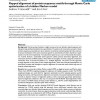Free Online Productivity Tools
i2Speak
i2Symbol
i2OCR
iTex2Img
iWeb2Print
iWeb2Shot
i2Type
iPdf2Split
iPdf2Merge
i2Bopomofo
i2Arabic
i2Style
i2Image
i2PDF
iLatex2Rtf
Sci2ools
BMCBI
2004
2004
Gapped alignment of protein sequence motifs through Monte Carlo optimization of a hidden Markov model
Background: Certain protein families are highly conserved across distantly related organisms and belong to large and functionally diverse superfamilies. The patterns of conservation present in these protein sequences presumably are due to selective constraints maintaining important but unknown structural mechanisms with some constraints specific to each family and others shared by a larger subset or by the entire superfamily. To exploit these patterns as a source of functional information, we recently devised a statistically based approach called contrast hierarchical alignment and interaction network (CHAIN) analysis, which infers the strengths of various categories of selective constraints from co-conserved patterns in a multiple alignment. The power of this approach strongly depends on the quality of the multiple alignments, which thus motivated development of theoretical concepts and strategies to improve alignment of conserved motifs within large sets of distantly related sequenc...
| Added | 16 Dec 2010 |
| Updated | 16 Dec 2010 |
| Type | Journal |
| Year | 2004 |
| Where | BMCBI |
| Authors | Andrew F. Neuwald, Jun S. Liu |
Comments (0)

